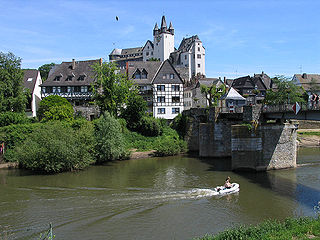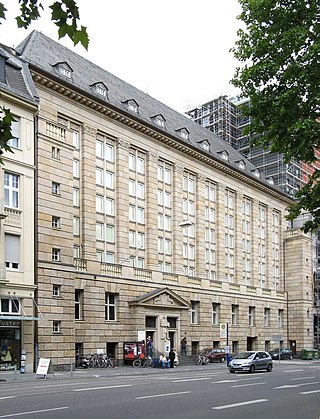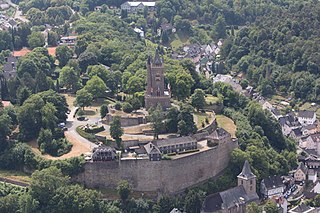
Herborn Castle (German : Schloss Herborn) is situated right above the city of Herborn, in the Lahn-Dill district of the state of Hesse, Germany.

Herborn Castle (German : Schloss Herborn) is situated right above the city of Herborn, in the Lahn-Dill district of the state of Hesse, Germany.
The Herborn castle was built as a Motte-and-bailey castle, part of the fortification of the city of Herborn and connected to the city wall surrounding the city. The castle was the center of the Herborn March, which was a fiefdom the Counts of Nassau received from the Landgrave of Hesse. [1]
The first documentation of the castle dates back to the 13th century. In 1251 the castle was renovated and at the beginning of the 14th century it was transformed into a manor house.
John VI, Count of Nassau-Dillenburg founded his Calvinist university the Herborn Academy and placed it in the castle in 1584 . Some time after 1588, [2] the school was moved to the old mayor house. In later years, years, the castle was rarely used by its owner.
From 1806 the castle was not in use and fell into ruin. It was eventually restored by Ludwig Hoffmann. Today it hosts the Theological Seminary of the Protestant Church in Hesse and Nassau.
Inside the castle there is a significant library of 68,000 works, at least 10,000 of which were printed before 1900. The library includes a collection of historical books as well printed materials from Herborn printers such as Corvin.

Herborn is a historic town on the Dill in the Lahn-Dill district of Hesse in Germany. Before World War I, it was granted its own title as Nassauisches Rothenburg. The symbol or mascot of this town is a bear. Scenic attractions include its half-timbered houses; Herborn is located on the German Timber-Frame Road. Herborn hosted the 26th Hessentag state festival in 1986, and the 56th Hessentag in 2016.

Katzenelnbogen is the name of a castle and small town in the district of Rhein-Lahn-Kreis in Rhineland-Palatinate, Germany. Katzenelnbogen is the seat of the Verbandsgemeinde Aar-Einrich.

William I of Nassau-Siegen, nicknamed the Elder or the Rich, was Count of Nassau-Siegen and half of Diez from 1516 to 1559. He was a descendant of the Ottonian Line of the House of Nassau.

Diez an der Lahn is a town in Germany's Rhein-Lahn district in Rhineland-Palatinate, on the borders of Hesse. Diez is the administrative seat of the municipality of Diez.

Nassau is a town located in the German state of Rhineland-Palatinate. It lies on the lower course of the Lahn River, on the mouth of the Mühlbach, between Limburg an der Lahn and the spa town of Bad Ems, and is located in the Nassau Nature Park, surrounded by the Westerwald to the north and the Taunus to the south. The town is on the German-Dutch holiday road, the Orange Route. As of 2021, it had a population of 4,592.
Walram II of Nassau was Count of Nassau and is the ancestor of the Walramian branch of the House of Nassau.
Otto I of Nassau was Count of Nassau and is the ancestor of the Ottonian branch of the House of Nassau.
The Dernbach Feud was an over 100-year-long ongoing dispute in present-day Germany between the House of Nassau, several knightly families, and the Landgrave of Hesse. The conflict erupted mainly over property rights in Herborn and the surrounding area.

Biebrich Palace is a Baroque residence (Schloss) in the borough of Biebrich in the city of Wiesbaden, Hesse, Germany. Built in 1702 by Prince Georg August Samuel of Nassau-Idstein, it served as the ducal residence for the independent Duchy of Nassau from 1816 until 1866.

Count John V of Nassau-Siegen, German: Johann V. Graf von Nassau-Siegen, official titles: Graf zu Nassau, Vianden und Diez, Herr zu Breda, was since 1475 Count of Nassau-Siegen and of half Diez. He descended from the Ottonian Line of the House of Nassau.
The Herborn Academy was a Calvinist institution of higher learning in Herborn from 1584 to 1817. The Academy was a centre of encyclopaedic Ramism and the birthplace of both covenant theology and pansophism. Its faculty of theology continues as the Theological Seminary of the Evangelical Church of Hesse and Nassau. The institution held the principle that every theory has to be functional in practical use, therefore it has to be didactic.

Count John I of Nassau-Siegen, German: Johann I. Graf von Nassau-Siegen, was since 1362 Count of Nassau-Siegen. He descended from the Ottonian Line of the House of Nassau.

Count Otto II of Nassau-Siegen, German: Otto II. Graf von Nassau-Siegen, was since 1343 Count of Nassau-Siegen. He descended from the Ottonian Line of the House of Nassau.

Henry I of Nassau-Siegen was Count of Nassau-Siegen, a part of the County of Nassau, and ancestor of the House of Nassau-Siegen. He comes from the Ottonian branch of the House of Nassau.

Count John II with the Helmet of Nassau-Siegen, German: Johann II. mit der Haube Graf von Nassau-Siegen, succeeded, with his brothers, his father in 1416 as Count of Nassau-Siegen. With his brothers, he inherited the County of Vianden in 1417, and also inherited half of the County of Diez in 1420. He descended from the Ottonian Line of the House of Nassau.

RheinMain University and State Library, formerly Nassau State Library and Hessian State Library, is funded by the State of Hesse and located in Wiesbaden and Rüsselsheim. With collections currently comprising over one million items, it is one of Germany's medium-sized libraries. The major special collection is on the former state of Nassau, in which the library has its roots. As of 1 January 2011 it became part of RheinMain University of Applied Sciences. It is a central service facility of the RheinMain University of Applied Sciences and provides literature for the population of the city and region.

Count John III the Younger of Nassau-Siegen, German: Johann III. der Jüngere Graf von Nassau-Siegen, succeeded, with his brothers, his father in 1416 as Count of Nassau-Siegen. With his brothers, he inherited the County of Vianden in 1417, and also inherited half of the County of Diez in 1420. He descended from the Ottonian Line of the House of Nassau.

Lindheim Castle is a former medieval castle in Lindheim, in the municipality of Altenstadt, Wetteraukreis county, in the German state of Hesse. In the Middle Ages the castle became a large joint inheritance or Ganerbschaft of lesser noble families, who were an important local power in the eastern Wetterau. In 1697, stately home, Schloss Lindheim, was built. Only a few remnants of both buildings have survived today.

Castle Dillenburg, in the provincial town of Dillenburg in Hesse-Nassau, is situated on a hill above the Dill river, 25 miles northwest from Gießen on the Giessen-Troisdorf railway line.
Prima Divisio is the term used by historians for the Family Treaty from 1255 containing the first division of the county of Nassau between the brothers Walram II and Otto I.